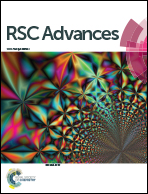CoMoO4 as a novel heterogeneous catalyst of peroxymonosulfate activation for the degradation of organic dyes†
Abstract
Sulfate radical-based advanced oxidation processes (SR-AOPs) are receiving more and more attention for the removal of recalcitrant organic pollutants. In this study, we employ CoMoO4 as a novel heterogeneous catalyst for peroxymonosulfate (PMS) activation to release powerful sulfate radicals for the first time. The CoMoO4, prepared through a hydrothermal route and high-temperature calcination, displays a hierarchical microstructure assembled from ultrathin nanosheets and a large surface area (61.9 m2 g−1). Methylene blue (MB) is selected as a model organic pollutant, and it is found that the CoMoO4/PMS system can realize 100% degradation of MB in 40 min and maintain its removal efficiency during three recycling experiments. Such a catalytic performance of CoMoO4 is indeed superior to those of conventional Co3O4 and CoFe2O4. The effects of some potential influential factors, including reaction temperature, dosages of PMS and CoMoO4 and the initial pH value are systematically evaluated. More importantly, the CoMoO4/PMS system not only shows its universality in the degradation of other organic dyes (e.g. orange II and rhodamine B), but also exhibits considerable degradation efficiency under some actual water background conditions. The quenching experiments confirm that sulfate radicals are the main active species for the degradation of dyes, and XPS spectra reveal that Co sites on the surface of CoMoO4 are the primary active sites for the generation of sulfate radicals.



 Please wait while we load your content...
Please wait while we load your content...